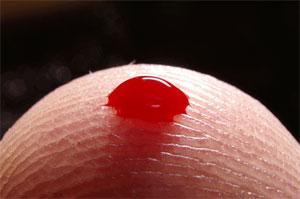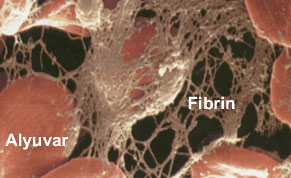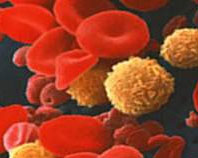 The process of blood clotting, also known as coagulation, is an extraordinary event due to the collective actions of a series of enzymes. This system is so flawless that when a part of our body is affected or injured in some fashion, we can instinctively know that as soon as the bleeding stops, repair to the affected or injured area will begin almost immediately. Our certainty stems from the fact that Allah has created this perfect system as a blessing and a mercy to us.
The process of blood clotting, also known as coagulation, is an extraordinary event due to the collective actions of a series of enzymes. This system is so flawless that when a part of our body is affected or injured in some fashion, we can instinctively know that as soon as the bleeding stops, repair to the affected or injured area will begin almost immediately. Our certainty stems from the fact that Allah has created this perfect system as a blessing and a mercy to us.
At the moment of injury, several processes are undertaken almost immediately by the body. Indeed, these processes could be counted in the several millions, and all of them occurring in little more than the blink of an eye. That which is responsible for coordinating and carrying out these innumerable activities are enzymes. These protein molecules are truly dazzling in their complexity and the duties performed by enzymes within the human body, so diverse and complex, carries great importance for us, for without the proper functioning of these enzymes, we would certainly perish. This serves as proof for Allah's magnificent creation, and of His boundless love and compassion for us. Let us now take a closer look at how the process of coagulation works.
The Battle Begins
When a part of our body is injured, either externally or internally, a sequence of events is activated. The body's first-aid system in the event of bleeding is platelets. When a blood vessel is damaged, certain proteins are activated, most notably a protein known as von Willebrand factor. This protein acts like a policeman at an accident scene; it signals that a blood vessel has been damaged, and it stops any platelets that it notices and gets them to remain at the scene. The first platelets on the scene send out signals to other platelets throughout the body, requesting help, much in the manner that a policeman may request backup for certain situations.
Enzymes initiate coagulation
Now that the first aid help has arrived, it's up to the enzymes to carry out the rest of the operation. Actually, there are several enzymes responsible up to this current stage, but let's focus on the enzymes that actually perform the blood clotting activities.
Our bodies always store enzymes that have been deactivated for use in the future. These enzymes receive their marching orders through a coded system and move accordingly, and only when its needed of them. Fibrinogen is an enzyme that flows freely within our bloodstream and it's an inactive enzyme, thus it is only used when required. It is fused within our blood plasma. Until a wound opens up, it swims freely within its area. However, in the situation of an injury, it will swiftly get into motion. This protein that circulates freely within the blood plasma, and isn’t subjected to any tasks ordinarily, proceeds to the affected area.
The net that forms the first clot
When a state of injury to a blood vessel is signalled within our body, a different type of enzyme is formed. Platelets cuts off two of the three rings that make up the fibrinogen protein chain. Fibrinogen now develops into a substance known as fibrin. So an enzyme that was previously inactive has now transformed into an active one. The surface of the area that has been injured has now developed into sticky, adhesive pieces. These adhesive pieces allows the fibrins to merge with other fibrin molecules. With the coming together of the fibrin molecules, an extended chain forms and with the cross over of proteins, a huge web is generated. This formation is the initial blood clot. Blood clots shortly after, and begins to build a cover over the entire wound just like a fish net.
Trapelets at the same time convert the factor XIII enzyme into an XIIIa enzyme. This conversion allows the fibrin clot to become more durable. (Robert K. Murray, Peter A. Mayes, Darly K. Granner, Victor W. Rodwell, Harper’s biochemistry, Bars Bookshop, 1993, page 783)
An Enzyme Chain that resembles the Chicken-Egg Conundrum
A platelet in its passive state is known as Pro-Platelet Basic Protein (PPBP). Thus, the platelet which is responsible for activating fibrinogen is typically in its basic inactive state, a pro-platelet that is existent in our blood. This situation carries great importance because if active state platelets were to continually circulate within our blood, it would soon transform all the fibrinogen in our blood in fibrin, and an uncontrolled state of clot formation would occur. Needless to say, such a situation would be life threatening. Therefore, an enzyme is required to convert or trigger pro-platelets into active proteins.
The activation of Pro platelets with the Stuart factor and accelerin
Pro-platelets are cut off by another enzyme named Stuart factor and thus transformed from a passive state into an active protein. Nevertheless, the same circumstance applies to Stuart factor enzymes as well as platelets; if Stuart enzyme were to circulate uncontrollably and continually within our blood, then it would be constantly stimulating the coagulation mechanism and thereby initiating the formation of blood clots within our body. This is why Stuart factor isn’t an active enzyme in our blood and must be activated in order to be effective.
For pro-platelets to be activated and mobilized, Stuart factor isn’t adequate to fulfill this process of conversion. An enzyme named accelerin gets into action jointly with Stuart factor to complete this process of transforming pro platelets into platelets.
Platelet responsible for mobilizing Accelerin
For blood clots not to be forming within our bodies unbounded and unchecked, another enzyme, known as accelerin, is also initially inactive. But in its activation process, we discover something of a quandary, resembling the egg-chicken conundrum, because the enzyme responsible for stimulating the accelerin enzyme is platelets. How can we explain the situation where an enzyme that is previously activated by accelerin, can reversibly activate its initiator? The reason for this is the Stuart factor enzymes that slow dissection of pro-platelets and thus the existence of a quantity of readily available platelets as a precautionary measure. The event of coagulation commences with this critical precautionary measure, and the mobilization of the clotting process develops with the initial movement of Stuart factor.
Ceasing clotting is also a duty of the enzyme
These are factors which constitute the system in which blood clotting is implemented. These enzymes know what to activate or deactivate, where to condense (provide a certain quantity of), and recognize which part of the body is in need of repair. Furthermore, they recognize when their operations must come to a halt. When a blood clotting operation commences on any section of the body or wounded area, there is of course a major risk issue if the clotting doesn't stop beyond a necessary stage. When clotting continues uncontrollably, a potentially hazardous situation arises for the body's vital organs, in which malfunctioning may occur and will cause congestion of blood vessels. For this reason, the enzymes must know when to stop coagulation. This termination signal is sent to them by other enzymes.
How is the clot removed when the wound has healed? The clot must be removed when the wounded area has recovered. For this operation, the job is again given to these molecules, enzymes. Plasmin is the enzyme which is given the task of virtually cutting the fibrin of blood clots, much like a pair of scissors. Plasmin influences the fibrin but has no effect on the inactive state of the fibrin which is fibrinogen. If this was the case, the post-clotting production task would become very difficult. Plasmin movement isn’t very swift. This is an advantage, for when the wound has formed, plasmin is also at work alongside the other enzymes, and the wound heals without it cutting the fibrins completely.
The clot must be removed when the wounded area has recovered. For this operation, the job is again given to these molecules, enzymes. Plasmin is the enzyme which is given the task of virtually cutting the fibrin of blood clots, much like a pair of scissors. Plasmin influences the fibrin but has no effect on the inactive state of the fibrin which is fibrinogen. If this was the case, the post-clotting production task would become very difficult. Plasmin movement isn’t very swift. This is an advantage, for when the wound has formed, plasmin is also at work alongside the other enzymes, and the wound heals without it cutting the fibrins completely.
Blood coagulation is one of the irreducible complex structures in our body
During the coagulation process, there are several other enzymes which come into play at different phases. Every one of them plays an important role in accomplishing the process of coagulation, and the malfunctioning of even one enzyme is unimaginable; this is what is known as an irreducible system factor. Writer James Perloff, once an extreme evolutionist now turned anti-evolutionist, and also an advocate of the truth of Creation, comments on the quandary put forward by evolutionists on the blood coagulation system, and also takes into account comments made by Michael Behe and further adds :
“The Blood coagulation (clotting) process is indeed complex, numerous proteins are in operation in this gradual phase, there is no other duty assigned to them other than there given function. Every single enzyme is in correlation to another and is triggered into motion by another. We can summarize Behe’s observation:
Which has evolved first? The enzymes or proteins? Its not the protein, hence it has no function without an enzyme which is required to activate it. Then why has nature evolved triggering enzymes beforehand? Without a protein, there is no purpose. Furthermore, if the blood coagulation underwent centuries of evolutionary phases to reach its perfect state, we should of witnessed countless livings beings corpses from loss of blood. This is an irreducible complex system”. worldnetdaily.com/news/ article.asp? ARTICLE_ID=21776)
Can a unique system, formed by hundreds of stages that we cannot simplify nor remove any part of, have come about by the accidental gathering of countless unconscious atoms ?
Can unconscious atoms create necessary enzymes required to fulfill the blood coagulation process by chance?
Can unconscious atoms create miracles by chance?
Can unconscious atoms create something from absolute nothingness?
Certainly these are impossible. Evolutionists , however claim that blind, unconscious atoms randomly coming together have accounted for the process in which a virtually conscious, operative blood coagulation system has come into being. Coincidence is Darwinism’s false deity to account for the so-called miracles it has constituted. This is why Darwinists deceptively try to convince people into believing that chance can create something or produce miracles or make something come into existence from absolute nothingness.
Therefore, it is impossible for perfect and organized systems to come into operation as a result of aimless, uncontrolled and unconscious events. Such complexity, as we see in the blood clotting system, and its magnificent detail, right down to the molecular level demonstrates that mere chance isn't enough to explain it. The coagulation system is extremely sensitive and requires a complex division of labor; even a single random event by chance would cause the complete system to be turned upside down, hence be rendered useless. This system, like several other systems in the human body, reflects Allah’s Sovereignty and Sublimity. Almighty Allah is the Creator of everything and every creature is submissive to Him and under His command. Allah decrees in the verse below:
“That is Allah , your Lord; there is no deity except Him, the Creator of all things, so worship Him. And He is Disposer of all things. Vision perceives Him not, but He perceives [all] vision; and He is the Subtle, the Acquainted.” (Surat Al-An'am: 102-103)
 The Blood coagulation is an extraordinary event and it occurs with a carefully coordinated movement of a number of enzymes. It is necessary for each enzyme to be at the right place at the right time and to perform their actions at the scheduled time. These numerous enzymes perform their tasks, and are aware of what is required of them at any given stage or time. This superb cooperativeness and flawless synchronicity in their assignments is the manifestation and blessings of the Lofty Supreme Creator, Allah.
The Blood coagulation is an extraordinary event and it occurs with a carefully coordinated movement of a number of enzymes. It is necessary for each enzyme to be at the right place at the right time and to perform their actions at the scheduled time. These numerous enzymes perform their tasks, and are aware of what is required of them at any given stage or time. This superb cooperativeness and flawless synchronicity in their assignments is the manifestation and blessings of the Lofty Supreme Creator, Allah.


